
VOICE Home Page: http://www.os2voice.org
[Previous Page] [Next Page]
[Features Index]
 VOICE Home Page: http://www.os2voice.org |
[Previous Page] [Next Page] [Features Index] |
|
Article by Isaac Leung
©June 2001 |
eComStation (eCS) is the latest product from Serenity
Systems. eCS is an operating system based on OS/2 technology licensed from IBM.
Users looking to move beyond OS/2 Warp 4 have 3 options:
Of course, if you're happy with Warp 4 today and it does all you need, you can
stay put. Some people are happily chugging along with Warp 3 Connect still. Those
of you who decide that you need more, IBM's Convenience Pack has already been released
and reviewed. This time, eCS has finally gone Gold, so we'll take a look at what's
in eCS and if it's for you.
Now, Serenity Systems doesn't really sell eCS directly. It owns it, and it produces
it, but from what I gather, they are much happier getting resellers to sell to,
and deal with the end-user. I know of 3 resellers that sell eCS. In Canada, it's
Jacaranda Business systems. In the US, it was Indelible
Blue (now Prism Data Works) and in
Europe, it is Mensys.
You'll still get exactly the same operating system, no matter who you deal with.
But the packaging of services and any extras will differ between the vendors. At
this point, there probably isn't too much difference, but who knows what innovative
new services they will come up with in the future.
I ordered mine from Jacaranda Business Systems (JBS). As with the other vendors,
there are various choices: the upgrade from Warp 4, a new license, SMP (for dual-CPU
or more systems) upgrade and a 2 year service extension. I just bought the basic
upgrade from Warp 4 which cost me $209CDN. Those of you interested in SMP machines
(I'm waiting for the dual Athlons to show up), it'll cost you $374CDN for the SMP
package. Not cheap, but far cheaper than Warp Server for e-Business (WSeB). It appears
that the cost difference for eCS to eCS-SMP is exactly the same as the SMP feature
upgrade for eCS, so I decided to hold off until I actually got the hardware.
Box? What box? Well, as I mentioned, each vendor will probably sell you a slightly
different package. In the case of JBS, I got a preview copy which was included in
a nice 3-ring binder (I mean a nice business quality one, not something that I'd
be ashamed to show a business client!), colour cover with the eCS and JBS logo and
some printed instructions. Now, I think they need to get a new colour printer, but
otherwise, it was very professionally done. I'd say "industrial grade"
as opposed to "consumer grade".
Now, that was the preview. I'd expect at least as good from the v1.00 (GA) release.
I don't know because I haven't received it from JBS yet. What I did manage to get
my hands on was a demo copy of the v1.00 Release Candidate shipped to me. (It should
be exactly the same as the normal copy, but it expires in 180 days).
The preview had just 2 CD's. In between that time and now, it seems Serenity
have been busy cramming in the goodies, as the v1.00 release came on 3 CD's.
Wow! I wonder what's been packed in there! I had some clue as to what's included
from news on the Internet, but there were apparently some significant inclusions
and changes to the GA version, and they were a bit tight-lipped about it. Well,
enough teasing, here's what I got for my $209:
Whew! There's quite a bit more, so don't be offended if I missed your favourite
application. Prior to GA release, Serenity (in addition to their own work), accepted
"adoptions" of users favourite applications and tools. The "adopter"
merely documented the location of all necessary files, CONFIG.SYS changes
and a wrote a short script. That's why there are so many!
Well, enough rambling about! What did I throw it on? My favourite test machine!
This was a rush shipment, so no hardcopy documentation came with it. Of course,
the first thing any self-respecting engineer did was to skip all the README's and
shove in the bootable CD and restart the machine. (My excuse is that I'm emulating
a typical user ;). Well, it didn't work. I checked my BIOS settings. Yes, it was
set to boot from floppy first, then CD, then hard disk. I try again. Still no dice.
Fortunately, the HP has a "Boot Menu" option to select the boot device
manually at startup time. I try that. Whew! It works! Chalk that up to slightly
buggy BIOS on the HP then. (If you do not have a bootable CD-ROM, you'll have to
make a set of bootable floppies, following the instructions included).
Booting from CD-ROM only about a second or two, and I got a blank screen with
a very simple menu at top left:
Okay, right away I have ideas for some improvements here, because that's all
that's on the screen. For me, it's almost obvious what to do. Press a key for the
option. But suppose it's a computer novice? What now? Is that really a menu? Or
maybe it's telling you the sequence of steps that's about to happen. I think they
should explicitly add a line here saying something like "Press [1,2 or
3] for a choice. If you don't press a key within 10 seconds, it will boot from your
hard disk". Which brings me to my second point. 10 seconds isn't enough
for a new user to read the options and decide what to do from here.
If you select the Advanced installation, it boots up to an initial setup
screen. It all happens quite quickly, maybe just a couple of seconds. For a computer
novice, it looks really daunting. It looks like the computer BIOS setup screen.
Mind you, speaking as an experienced computer user, I have little to gripe about.
There's options for just about everything, from screen depth and resolution, to
SCSI boot device, magneto-optic disks, etc, so I think that will make all the advanced
users quite happy. But for computer novices, it could be arranged a bit better.
(I suppose instead of complaining, I should whip up a mockup explaining my ideas).
On the other hand, new users should've probably booted up with the Default
settings.
Once you continue past this screen, it proceeds to boot to the eCS Desktop. If
you had chosen the Default installation, it would've skipped the advanced
setup screen and booted directly to the desktop. My advice even for advanced users?
Unless you have really odd hardware, just use the Default installation. It works
nicely.
The boot process will look familiar to experienced OS/2 users. It's nearly the
same, but the Warp 4 screen has been replaced by a stylish eCS logo. At the bottom,
the drivers being loaded are displayed, as if you'd pressed ALT-F2 during
OS/2 bootup. For new users, there's no evidence of OS/2's genes yet. I found the
initial boot time to the graphical GUI install to be fairly fast, quicker than my
normal Warp 4 boot time to desktop.
And here, even before you start any real installation, you get your first taste
of the new eCS desktop. At this stage, there is still no obvious indication that
OS/2 is under the hood, unless you are already an OS/2 user. Oh, and by the way,
it is nice. Really nice. If you haven't seen it before, you will be impressed,
I can almost guarantee it. It even pops up a short video clip of the eCS logo for
your view pleasure while it's busy initializing the scripts or something. (Note:
the video didn't seem to pop up during Default installation, but showed up
on Advanced installation. I don't know if that's considered a bug or not).
Let me pause a bit, not to brag, but to put into perspective the amount of work
Serenity has put into the initial install experience. I've installed just about
every Microsoft operating system from DOS 3.30 on up to Windows 2000, I've done
MacOS up to 9.1, I've done OS/2 from 1.3EE on up to MCP, I've done RedHat Linux,
even BeOS R5 and QNX. This initial setup is arguably the easiest, slickest and nicest
looking one I've seen. (And much, much faster than WinNT or Win2000). Only Mac OS
X might give it a good run for its money. Nearly all the icons have been re-done.
The title bar sports a nice gradient and the close button is re-done, as are all
the checkboxes and dialog buttons. Too bad the only thing missing is anti-alias
fonts.
The install screen takes up most of the desktop, it is very well laid out, with
several items on the left hand side, including "Welcome", "CD contents",
"Installation planning", "Installationg procedure", "Volume
Management" and "Install eComStation". The info is shown in a large
pane just to the right. The WarpCenter (or rather, the eCS center now) is put on
the bottom by default. Unless you are very familiar with OS/2, you will not recognize
this as OS/2. There are no obvious clues. For first impressions, it is nice!
Serenity and their gang have really done their homework here. If initial impressions
count for anything, I'd have to give pretty much full marks right away. Don't believe
me? Have a look at the picture.
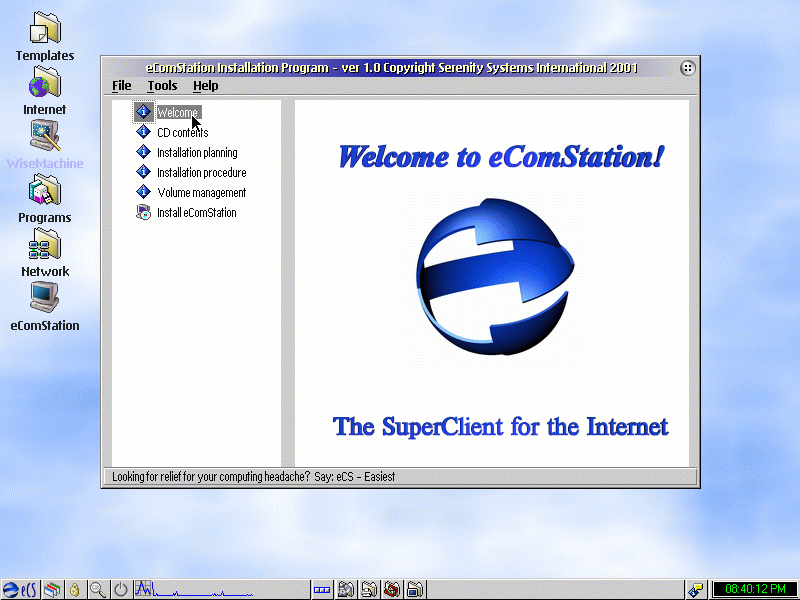
![]() The left
pane in the setup window does more than show pretty pictures. Clicking on each of
the options on the left can bring up useful information, as well as buttons to launch
other tasks. In the example below, clicking on the "Planning Guide" will
bring up a .PDF Acrobat Reader and a copy of the WSeB Planning Guide. Come
on! Be honest now, if it weren't for the Warp Sans font, would you ever know OS/2
was under the hood?
The left
pane in the setup window does more than show pretty pictures. Clicking on each of
the options on the left can bring up useful information, as well as buttons to launch
other tasks. In the example below, clicking on the "Planning Guide" will
bring up a .PDF Acrobat Reader and a copy of the WSeB Planning Guide. Come
on! Be honest now, if it weren't for the Warp Sans font, would you ever know OS/2
was under the hood?
![]() Being in a bit
of a rush (and still trying to emulate the typical user ;), I skipped reading all
the instructions and clicked on the last option "Install eComStation"!
My impatience was rewarded with another new screen:
Being in a bit
of a rush (and still trying to emulate the typical user ;), I skipped reading all
the instructions and clicked on the last option "Install eComStation"!
My impatience was rewarded with another new screen:
If you want to be safe, I suppose you could select Classic VGA for the video
mode. But I've been there, done that. Tried IBM GENGRADD too, so might as well give
the SciTech drivers a shot and see how well that turns out. One thing to note, you
are warned not to install select the SMP installation unless you have the
hardware for it right now. Don't install it "just in case"!
![]() Next up,
is choosing the destination volume. Now, I've got it easy. I've already applied
MCP, had my volumes converted and it's already active. Users who use a second operating
system and did not partition their hard drive in anticipation of eCS may be in for
a bit more of a headache. (Now fortunately, Serenity is planning demo CD's which
have a fully bootable and useable system so you can preview eCS without having to
change your hard drive at all. It should be coming shortly).
Next up,
is choosing the destination volume. Now, I've got it easy. I've already applied
MCP, had my volumes converted and it's already active. Users who use a second operating
system and did not partition their hard drive in anticipation of eCS may be in for
a bit more of a headache. (Now fortunately, Serenity is planning demo CD's which
have a fully bootable and useable system so you can preview eCS without having to
change your hard drive at all. It should be coming shortly).
Once you choose the volume, you have the option of keeping all previous files
on that volume (if that applies) or doing a short or long format. I first tried
keeping the volume, to see if that worked. Afterwards, I also did the quick format
to finally cleanse my system of all old "junk". If you are installing
over an existing OS/2 installation, it also gives you the option of overwriting
all files with newer time stamps, don't overwrite any of them, or prompting you
for a choice each time it encounters one.
![]() Finally, a
couple of steps later, it starts the install. Nice work here too! There's a pie
chart indicating the approximate percentage complete, as well as text labels. This
part is really cool (at least I thought so) because the text auto centers itself
around its share of the pie slice as it changes so it looks like it's orbiting the
chart. Well, you'll just have to see it for yourself.
Finally, a
couple of steps later, it starts the install. Nice work here too! There's a pie
chart indicating the approximate percentage complete, as well as text labels. This
part is really cool (at least I thought so) because the text auto centers itself
around its share of the pie slice as it changes so it looks like it's orbiting the
chart. Well, you'll just have to see it for yourself.
Once it's done, it pops up a credits screen listing all the contributors. I believe
it's a hacked up version of OS/2's original AAAAA.EXE. I guess I appreciate
the effort, but my is it ever ugly compared to the screens that came before it.
After you've had enough, the system reboots.
Once it reboots, you get another installation screen with a list of steps to
do:
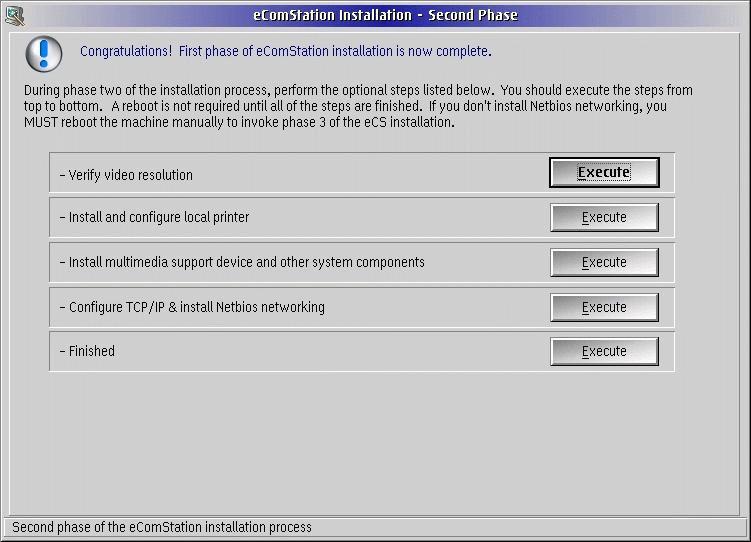
Pretty straightforward to follow, each of the buttons is highlighted in turn
as you finish the previous step. Now, unfortunately, here's the first "letdown".
Okay, I shouldn't put it that way. This is where all the customizations start to
come to an end, at least for this first release of eCS. Selecting "Verify video
resolution" just brings up the Display section of the OS/2 "System"
object under System Setup. Jumping to "Install multimedia support device and
other system components" brings up the standard OS/2 Warp 4 "Selective
Install". Even the background bitmap still says OS/2. Esthetics aside, it's
a bit of a problem, because you have to not touch the video or CD-ROM settings
(unless you have a 2nd CD-ROM). You are explicitly warned of this, but still a bit
of a hassle. I understand this is not an oversight, but due to a bit of a problem
working replacing OS/2's Selective Install. I'm sure they'll figure it out sooner
or later.
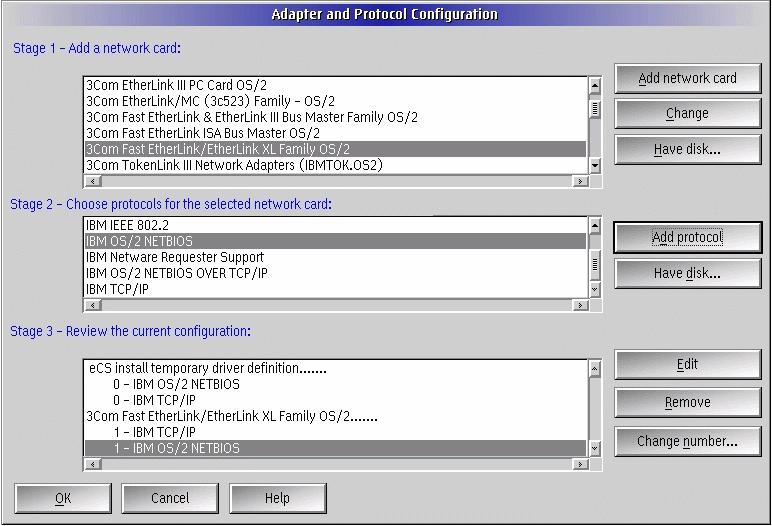 Now, I think, the Networking install
gets a bit weird here (mind you, it is so much faster than Warp 4's networking
installation though). First, you configure TCP/IP, which, if you are hooked up via
LAN, usually just involves clicking on the "use DHCP" button on the standard
Java TCP/IP 4.3 booklet. Then when you finish, it reboots, and then you use
the good ol' MPTS to actually install your network interface card (NIC). Apparently
the new install assigns a dummy NIC so that your networking can be configured first.
And then following, you change it to your actual NIC. Or at least that's what I
figured out the process to be. It worked anyways. (Pretty good for not reading the
manual, huh? :). The MPTS configuration screen has been nicely updated too to be
more clear.
Now, I think, the Networking install
gets a bit weird here (mind you, it is so much faster than Warp 4's networking
installation though). First, you configure TCP/IP, which, if you are hooked up via
LAN, usually just involves clicking on the "use DHCP" button on the standard
Java TCP/IP 4.3 booklet. Then when you finish, it reboots, and then you use
the good ol' MPTS to actually install your network interface card (NIC). Apparently
the new install assigns a dummy NIC so that your networking can be configured first.
And then following, you change it to your actual NIC. Or at least that's what I
figured out the process to be. It worked anyways. (Pretty good for not reading the
manual, huh? :). The MPTS configuration screen has been nicely updated too to be
more clear.
![]() At this reboot,
the installation is basically complete and you're down to adding applications, utilities
and customizing. Yes, for this, Serenity has provided yet another slick little procedure.
At this reboot,
the installation is basically complete and you're down to adding applications, utilities
and customizing. Yes, for this, Serenity has provided yet another slick little procedure.
You can go through to set the eCS Clock (this is no ordinary clock!), and change
the look and feel. Unfortunately, those "Start" buttons never seemed to
launch anything for me. Yes, I tried it once with the Default installation over
the messy old OS/2 installation, and a 2nd time with the Advanced install, on a
clean formatted partition. Still no good. The hard disk seem to chug a bit, but
nothing ever came up.
Oh well, despite that minor glitch, I charged on. The following tabs allow you
to install extra applications such as SmartSuite, the old IBM Bonus Pak, and others.
Some of them simply call up the standard OS/2 installer, some use the Serenity's
WiseMachine to do the installation. Either way, all of them installed just fine.
Obviously there are a few cosmetic changes from the buttons, to the window titles
and frame controls. Dialog boxes and configuration screens have received quite a
few updates and even the shutdown sequence sports a new dialog with 2 options now
(Shutdown and Restart). In addition, there are some extra utilities and programs
included from the base Warp 4. The applications are already listed above. Other
little goodies include a simple calculator:
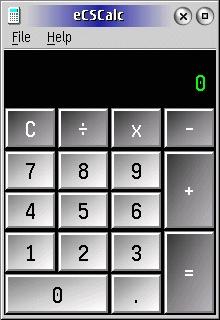
As well as the eCS clock. Although it didn't start with the "End of eCS
Installation" dialog, you can always access it from the "System Setup"
folder.
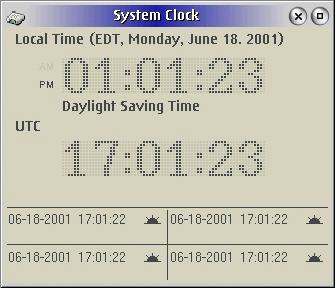
Not only does it look better, it's also packed with more functions. ![]()
You can have it automatically update the system clock for Daylight Savings Time,
or synchronize itself with some atomic clock service on the Internet. Good stuff!
![]() Next up, there is also a Task Planner
to shedule reminders and tasks in conjunction with the Task Scheduler (which is
automatically put in the Startup folder).
Next up, there is also a Task Planner
to shedule reminders and tasks in conjunction with the Task Scheduler (which is
automatically put in the Startup folder).
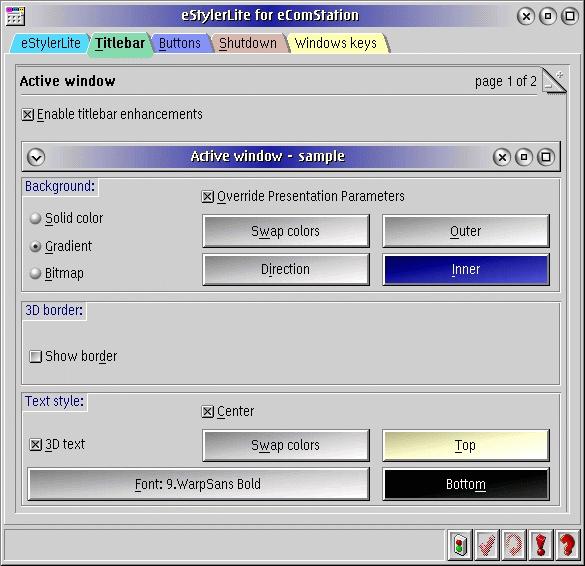 It's not all work for eCS!
In the "System Setup" folder, you'll find configuration panels for changing
eCS' look too. Included in eCS is a special version of Alessandro Cantatore's Styler/2
utility.
It's not all work for eCS!
In the "System Setup" folder, you'll find configuration panels for changing
eCS' look too. Included in eCS is a special version of Alessandro Cantatore's Styler/2
utility.
Go ahead, play with it! There are so many options. You can also change the frame
control and button styles with frame control themes. There's no shaped windows yet,
but it's a start! ![]()
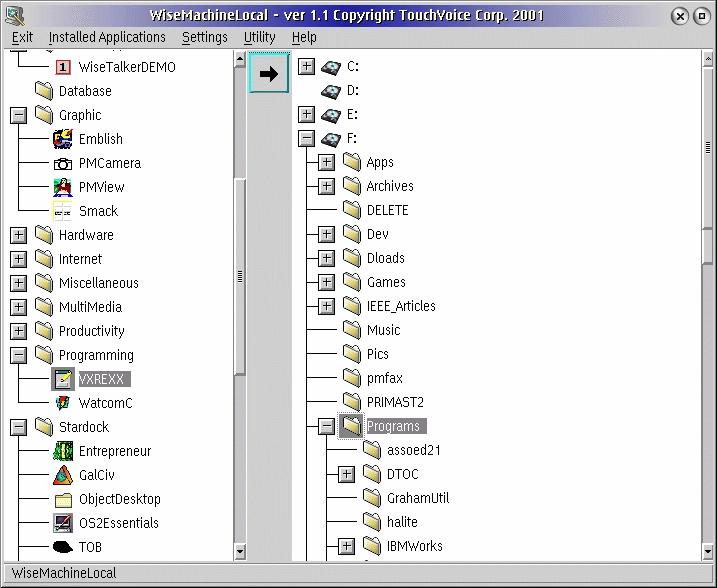 A Serenity special is the
WiseMachine installation utility. In a way, I guess it's a bit like Red Hat's RPM
manager, if you're familiar with that. (Though I gather WiseMachine is much more
powerful, although you may not realize it if you're using it on a local machine
only. I've heard you'll really have to see it demo'd as a system administrator on
a large LAN to be well and truly impressed). On a local machine, you can use it
to install any package that's available, just by selecting it and pointing to a
destination. WiseMachine takes care of all modifications to CONFIG.SYS
and anything else that's required.
A Serenity special is the
WiseMachine installation utility. In a way, I guess it's a bit like Red Hat's RPM
manager, if you're familiar with that. (Though I gather WiseMachine is much more
powerful, although you may not realize it if you're using it on a local machine
only. I've heard you'll really have to see it demo'd as a system administrator on
a large LAN to be well and truly impressed). On a local machine, you can use it
to install any package that's available, just by selecting it and pointing to a
destination. WiseMachine takes care of all modifications to CONFIG.SYS
and anything else that's required.
As you can see, there are a lot of software represented in WiseMachine's "database".
Wait, before you get too excited, no, Watcom C and VxRexx are not included in the
eCS distribution. If you try to install non-existent packages, nothing will happen.
You can use options in WiseMachine to install Odin and Realplayer painlessly
too. It's a simple matter of just clicking buttons and letting the computer do its
work. I'd never thought I'd see RealPlayer 8 being installed from the WPS! 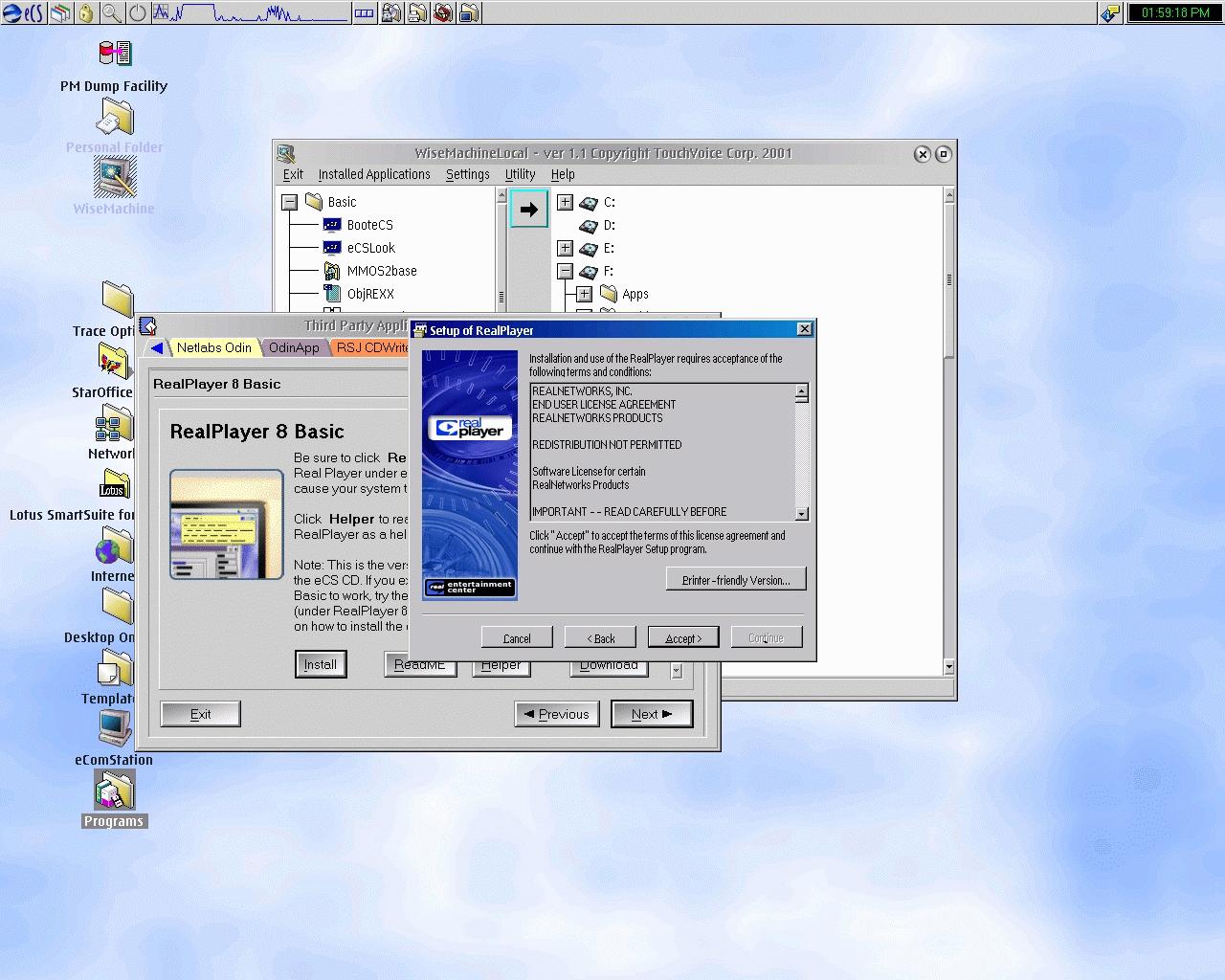
It's an impressive trick, not only because Odin got it to work, but because Serenity
has made it so easy to install. You don't have to be a hard-core hacker typing away
at the command-line to get it to work.
Well, there's always gripes, isn't there? Nothing's ever perfect, but I think
(so far) I haven't got a lot to complain about. There seemed to be a few glitches
in the final installation phase, as I noted previously, but nothing killer. These
features are accessible from elsewhere in the system. More problematic is the OS/2
Selective Installation routine which hasn't been replaced yet. I hope Serenity figure
out a way to get around that, which is the only sore spot in an otherwise very slick
installation routine.
There were a couple of pieces of software "included" in the GA Release
Candidate release that weren't actually included, which is a bit of a shame. I think
everyone would prefer to have it on CD rather than having to download it, but I
guess Serenity just ran out of time. The official eComStation
Web Site still isn't fully live, so I couldn't download those missing applications.
I hope that it does get fully up and running by the time people receive their GA
copies.
Finally, I have some personal, subjective complaints (which I'm sure I'll get
over). One of which is that the layout of the system is somewhat like the default
OS/2,but not quite. I guess I'm used to looking for things in certain locations
and looking for "OS/2" on the command prompt icons, which no longer have
that now. It'll slow me down a bit until I get used to it. And also, I think MCP
and eCS are guilty of this, the Warpcenter or eCS-Center now default to the bottom
of the screen. Great for Windows migrants I suppose, but not the best user-interface
choice. It should have defaulted to the top of the screen like it used to be. Like
how MacOS has it. Like how research has shown that's where it's supposed to be.
Sorry! I'm grasping for problems here!
Serenity Systems has licensed OS/2 from IBM, given it quite a major facelift
and added a few goodies to make their own baby, eComStation. It looks much prettier
on top, but still sports OS/2's powerful underpinnings. The best part is that this
is only the first release! Things can only go uphill from here. I think they extent
and quality of the work that has been put into eComStation shows that Serenity Systems
is serious about making eCS a success. The release date slipped a bit from initial
projections, but that time seems to have been used wisely to make this a pretty
solid release.
Extra support for eComStation can be purchased, but most users will make do with
the free support from the eCS Newsgroups
or the eComStation web site.
Given the amount of changes and enhancements that eCS has on top of OS/2, and
the bundle of included software, eComStation seems like a good value for your money.
If you like Lotus Smartsuite, the inclusion of this alone is nearly enough to justify
purchasing eComStation. On top of that, if you didn't purchase Stellar Frontier
(quite an addictive game, the subject for another review), this is the only way
to get the full version for OS/2. The quality of this first release is of a very
good level, at least as good as the MCP that IBM released. If you decide that you
need to move beyond your current OS/2 needs, I think eComStation is one very good
alternative.
Article References:Official eComStation Web Site: http://www.ecomstation.com |